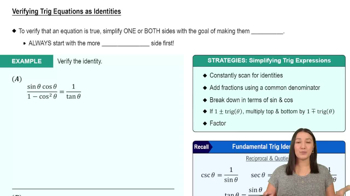Find the intervals on which ƒ(𝓍) = ∫ₓ¹ (t―3) (t―6)¹¹ dt is increasing and the intervals on which it is decreasing.
Table of contents
- 0. Functions7h 54m
- Introduction to Functions16m
- Piecewise Functions10m
- Properties of Functions9m
- Common Functions1h 8m
- Transformations5m
- Combining Functions27m
- Exponent rules32m
- Exponential Functions28m
- Logarithmic Functions24m
- Properties of Logarithms36m
- Exponential & Logarithmic Equations35m
- Introduction to Trigonometric Functions38m
- Graphs of Trigonometric Functions44m
- Trigonometric Identities47m
- Inverse Trigonometric Functions48m
- 1. Limits and Continuity2h 2m
- 2. Intro to Derivatives1h 33m
- 3. Techniques of Differentiation3h 18m
- 4. Applications of Derivatives2h 38m
- 5. Graphical Applications of Derivatives6h 2m
- 6. Derivatives of Inverse, Exponential, & Logarithmic Functions2h 37m
- 7. Antiderivatives & Indefinite Integrals1h 26m
- 8. Definite Integrals4h 44m
- 9. Graphical Applications of Integrals2h 27m
- 10. Physics Applications of Integrals 3h 16m
- 11. Integrals of Inverse, Exponential, & Logarithmic Functions2h 34m
- 12. Techniques of Integration7h 41m
- 13. Intro to Differential Equations2h 55m
- 14. Sequences & Series5h 36m
- 15. Power Series2h 19m
- 16. Parametric Equations & Polar Coordinates7h 58m
8. Definite Integrals
Fundamental Theorem of Calculus
Problem 5.5.90
Textbook Question
Integrals with sin² 𝓍 and cos² 𝓍 Evaluate the following integrals.
∫₀^π/⁴ cos² 8θ dθ
 Verified step by step guidance
Verified step by step guidance1
Step 1: Recognize that the integral involves cos²(8θ). To simplify this, use the trigonometric identity cos²(x) = (1 + cos(2x)) / 2.
Step 2: Substitute the identity into the integral. The integral becomes ∫₀^(π/4) [(1 + cos(16θ)) / 2] dθ.
Step 3: Split the integral into two separate integrals: (1/2) ∫₀^(π/4) 1 dθ + (1/2) ∫₀^(π/4) cos(16θ) dθ.
Step 4: Evaluate the first integral, (1/2) ∫₀^(π/4) 1 dθ, which is straightforward as it represents the area under a constant function. For the second integral, (1/2) ∫₀^(π/4) cos(16θ) dθ, use the formula for the integral of cos(kx), which is (1/k) sin(kx).
Step 5: Apply the limits of integration (0 to π/4) to both parts of the integral. For the first part, calculate the result of (1/2) θ evaluated at the limits. For the second part, calculate (1/2) * (1/16) * sin(16θ) evaluated at the limits.
 Verified video answer for a similar problem:
Verified video answer for a similar problem:This video solution was recommended by our tutors as helpful for the problem above
Video duration:
3mPlay a video:
Was this helpful?
Key Concepts
Here are the essential concepts you must grasp in order to answer the question correctly.
Trigonometric Identities
Trigonometric identities are equations involving trigonometric functions that are true for all values of the variables. Key identities include the Pythagorean identities, such as sin²(x) + cos²(x) = 1, and double angle formulas. These identities are essential for simplifying integrals involving sin²(x) and cos²(x), allowing for easier evaluation.
Recommended video:

Verifying Trig Equations as Identities
Integration Techniques
Integration techniques are methods used to find the integral of a function. Common techniques include substitution, integration by parts, and using trigonometric identities to simplify the integrand. For integrals involving cos²(θ), applying the identity cos²(θ) = (1 + cos(2θ))/2 can transform the integral into a more manageable form.
Recommended video:

Integration by Parts for Definite Integrals
Definite Integrals
Definite integrals calculate the area under a curve between two specified limits. The notation ∫ₐᵇ f(x) dx represents the integral of f(x) from a to b. Evaluating definite integrals often involves finding the antiderivative of the function and applying the Fundamental Theorem of Calculus, which states that the definite integral can be computed by evaluating the antiderivative at the upper and lower limits.
Recommended video:

Definition of the Definite Integral

 6:11m
6:11mWatch next
Master Fundamental Theorem of Calculus Part 1 with a bite sized video explanation from Patrick
Start learningRelated Videos
Related Practice
Textbook Question
15
views
